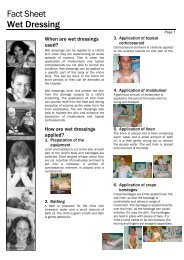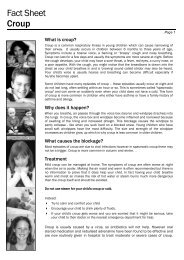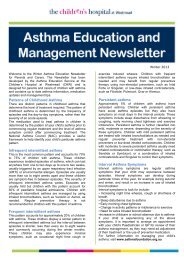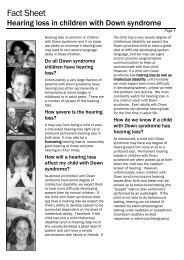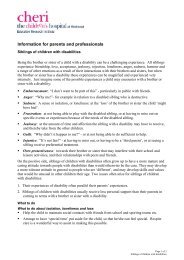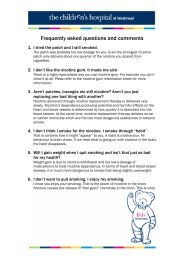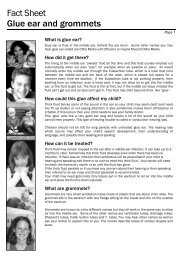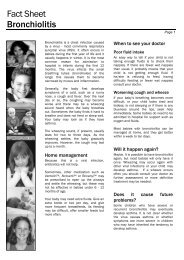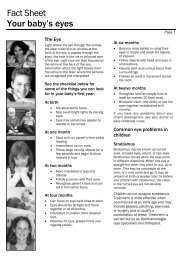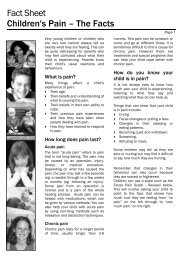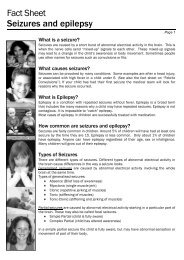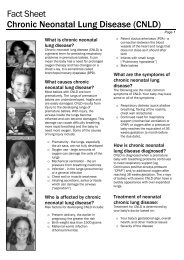transporting children with special needs - Kids Health @ CHW
transporting children with special needs - Kids Health @ CHW
transporting children with special needs - Kids Health @ CHW
You also want an ePaper? Increase the reach of your titles
YUMPU automatically turns print PDFs into web optimized ePapers that Google loves.
TRANSPORTING CHILDREN WITH SPECIAL NEEDS<br />
This document reflects that which is currently regarded as safe practice, however, as in any clinical<br />
situation there may be factors, which cannot be covered by a single set of guidelines. This<br />
document does not replace the need for the application of clinical judgement to each individual<br />
presentation.<br />
© The Children’s Hospital at Westmead - Valid only on the day of printing – discard immediately after use.<br />
Transporting Children With Special Needs<br />
Page 1 of 27
CONTENTS<br />
1. TRANSPORTING CHILDREN WHEN THE REGULAR CAPSULE, CHILD RESTRAINT OR SEAT<br />
BELT IS NOT SUITABLE<br />
1.1 Recommended process for <strong>transporting</strong> <strong>children</strong> <strong>with</strong> <strong>special</strong><br />
<strong>needs</strong><br />
2. GENERAL INFORMATION FOR TRANSPORTING CHILDREN WITH SPECIAL NEEDS<br />
2.1 Australian Standards<br />
2.2 Standard child restraints<br />
2.3 Guidelines for the prescriber<br />
2.4 Modifications<br />
2.5 Use of additional padding (soft modifications)<br />
2.6 Explanations to parents<br />
2.7 Fitting stations<br />
3. CONDITIONS AND DISABILITIES THAT MAY REQUIRE MODIFICATION TO<br />
CHILD RESTRAINTS OR TRANSPORT OPTIONS<br />
3.1 Head and trunk control problems, including weakness<br />
3.2 Behavioural problems<br />
3.3 Airway problems<br />
3.4 Children <strong>with</strong> connective tissue disorders, awkward shapes<br />
3.5 Plasters, orthopaedic patients<br />
3.6 Children in wheelchairs/<strong>special</strong>ised buggies<br />
4. CONTACT INFORMATION<br />
5. APPENDICES<br />
1a Use of a modified restraint – parent letter<br />
1b Use of an E-Z-ON-Vest – parent letter<br />
2a Travelling in a wheelchair - SPOT<br />
2b Travelling in a vehicle in a wheelchair - TranSPOT<br />
3a General guidelines for <strong>transporting</strong> <strong>children</strong> <strong>with</strong> disabilities -<br />
TranSPOT<br />
3b General guidelines for <strong>transporting</strong> students <strong>with</strong> disabilities<br />
- TranSPOT<br />
4a Transporting <strong>children</strong> <strong>with</strong> <strong>special</strong> <strong>needs</strong>, a guide to using<br />
child restraints in vehicles - TranSPOT<br />
4b Transporting <strong>children</strong> <strong>with</strong> <strong>special</strong> <strong>needs</strong> - TranSPOT<br />
© The Children’s Hospital at Westmead - Valid only on the day of printing – discard immediately after use.<br />
Transporting Children With Special Needs<br />
Page 2 of 27
1. TRANSPORTING CHILDREN WHEN THE REGULAR CAPSULE, CHILD RESTRAINT OR SEAT BELT<br />
IS NOT SUITABLE<br />
Hospital staff and parents expect <strong>children</strong> to be sent home from hospital in<br />
the safest possible way. Problems arise when the challenge of a child in bulky<br />
plasters, <strong>with</strong> respiratory compromise, poor head control, generalised rigidity<br />
or a behavioural disorder makes it impossible to use the regular capsule,<br />
infant/child restraint or seat belt. The following aims to act as a guide to staff<br />
in outlining how best to address these difficult problems.<br />
Conditions and disabilities have been allocated to one of five categories. It is<br />
hoped that these are sufficiently encompassing to allow staff to use the<br />
recommended options so that <strong>children</strong> <strong>with</strong> differing conditions may be<br />
transported safely.<br />
These guidelines can also be used in outpatient settings by clinicians to<br />
provide advice and information for parents, if their child has a medical<br />
condition or disability which makes it difficult to use the common transport<br />
options.<br />
1.1 Recommended process for <strong>transporting</strong> <strong>children</strong> <strong>with</strong> <strong>special</strong> <strong>needs</strong><br />
Critical Pathway<br />
Discussion of potential transport problems should commence when<br />
planning for admission.<br />
The parent/carer should be encouraged to bring the child’s own<br />
restraint in to assess its suitability early in the treatment phase.<br />
Assess child’s transport <strong>needs</strong><br />
The Occupational Therapist will assess the child <strong>with</strong> complicated postural<br />
difficulties or poor head control, or the child in need of customised adaptations.<br />
The therapist will:<br />
Try the child in an Australian Standards approved capsule, infant/child<br />
restraint or seat belt (this can be done on the ward/in the department or in<br />
the vehicle that the child will be transported in.)<br />
Ask the parent/carer to have the restraint fitted by an authorised fitter or<br />
at an authorised fitting station.<br />
Demonstrate to the parent/carer the placing of the child in the child<br />
restraint device.<br />
Refer to the appropriate section of this document, if modifications are<br />
needed.<br />
Document all modifications, recommendations and advice given to<br />
parent/carer in the child’s medical record.<br />
Complete the letter in appendix 1a and/or 1b and provide copies to the<br />
parent/carer.<br />
2. GENERAL INFORMATION FOR TRANSPORTING CHILDREN WITH SPECIAL NEEDS<br />
Listed below are the recommendations of Australian Standards for child<br />
restraints. However, an exemption may be required and granted on the grounds of<br />
the child having a medical condition that makes it impossible to use an Australian<br />
Standards approved restraint. In these instances, modified child restraints are<br />
available for use in Australia. Although these may have been tested overseas,<br />
usually they have not been tested to current Australian Standards. If a non-<br />
Standards approved child restraint is recommended for a child, the<br />
documentation contained in appendix 1a and/or 1b must be completed for the<br />
child and copies provided to the parent/carer.<br />
© The Children’s Hospital at Westmead - Valid only on the day of printing – discard immediately after use.<br />
Transporting Children With Special Needs<br />
Page 3 of 27
2.1 Australian Standards<br />
This document should be used in conjunction <strong>with</strong> the relevant Australian<br />
Standards documents outlined in the ‘Special Note’ section at the end of the<br />
document.<br />
2.2 Standard Australian child restraints<br />
Recommendations of Australian Standards for child restraints include:<br />
A child restraint should not weigh more than 9kg.<br />
Any child restraint should be used by one occupant only.<br />
A chest cross-strap shall allow release of the occupant by a tear-away<br />
action.<br />
Any removable cover must be able to be detached independent of the<br />
harness.<br />
Any removable cover must be well secured to prevent the occupant<br />
gaining access to foam or polystyrene.<br />
When a buckle is used, a single pressing operation should activate a<br />
quick-release device. The buckle should be red or orange.<br />
Infant Restraints:<br />
Any restraining harness shall have no less than 5 points of attachment.<br />
Most infant restraints face the rear of the vehicle and are suitable for<br />
infants of a weight no greater than 9kg and a supine length up to<br />
700mm.<br />
Child Restraints:<br />
Any restraining harness shall have at least 5 points of attachment.<br />
The average recline angle for child car seats shall be no greater than<br />
45 degrees.<br />
The back of the restraint must be higher than the level of the child's<br />
eyes.<br />
Forward facing seats are suitable for <strong>children</strong> weighing between 8-<br />
18kg.<br />
Adequate head and trunk control are recommended before the child<br />
can be placed in a forward facing seat.<br />
Child Safety Harness:<br />
If a child safety harness or H-Harness is used in conjunction <strong>with</strong> a<br />
booster seat the weight of the occupant must be between 14-26kg.<br />
The maximum allowable weight of a booster seat plus an occupant<br />
using the child safety harness is 27kg.<br />
If a harness is used <strong>with</strong>out a booster seat, the weight of the occupant<br />
must be between 14-32kg.<br />
The harness can be used <strong>with</strong> a standard lap belt or lap-sash belt <strong>with</strong><br />
a seat belt converter.<br />
Booster Seats:<br />
Ideally, the use of booster seats (<strong>with</strong> back attached) is recommended<br />
in preference to the use of booster cushions.<br />
Use of a “safefit” as a seat belt converter is recommended<br />
(http://www.safefit.com/2005/ontheroad.html;<br />
© The Children’s Hospital at Westmead - Valid only on the day of printing – discard immediately after use.<br />
Transporting Children With Special Needs<br />
Page 4 of 27
http://www.matson.com.au/safefit.html). NB: airway safety must be<br />
considered.<br />
Booster seats are for <strong>children</strong> weighing 14-26kg. They can be used in<br />
conjunction <strong>with</strong> a child harness or <strong>with</strong> an adult lap-sash seat belt.<br />
No anchorage point is required if the maximum weight of the seat is no<br />
greater than 2kg.<br />
If the seat is fitted <strong>with</strong> an upper anchorage strap, the maximum weight<br />
of the seat must be no greater than 4kg and the weight of the back of<br />
the seat no greater than 2kg.<br />
When seated in the booster seat, the back of the vehicle seat must be<br />
above the level of the child's eyes.<br />
Booster seats can provide limited postural support and the child can be<br />
positioned so that the lap-sash belt fits properly. Motion sickness may<br />
also be prevented <strong>with</strong> the child being able to see out the window.<br />
Booster Cushions:<br />
Booster cushions are for <strong>children</strong> weighing 14-26kg.<br />
The maximum weight of a booster cushion must be no greater than<br />
3kg.<br />
Booster cushions may be used in conjunction <strong>with</strong> a child harness or<br />
<strong>with</strong> an adult lap-sash seat belt.<br />
When seated on the booster cushion, the back of the vehicle seat must<br />
be above the level of the child's eyes.<br />
Child's<br />
Weight<br />
Birth<br />
8kgs<br />
9kgs<br />
11kgs<br />
12kgs<br />
14kgs<br />
18kgs<br />
26kg<br />
CHOOSING THE RIGHT CHILD RESTRAINT FOR A CHILD<br />
Approx<br />
Age of<br />
Child<br />
Birth<br />
5-6<br />
months<br />
6<br />
months<br />
12<br />
months<br />
2 years<br />
3 years<br />
4years<br />
7years<br />
Birth to<br />
9kgs<br />
Infant<br />
Restraint<br />
Birth to<br />
18kgs<br />
Convertible<br />
Restraint<br />
8 to<br />
18kgs<br />
Child<br />
Restraint<br />
8 to<br />
26kgs<br />
Child<br />
Restraint<br />
& Booster<br />
seat<br />
Adapted from Britax Child-care Products Pty Ltd. Safety and your family (July<br />
2000)<br />
© The Children’s Hospital at Westmead - Valid only on the day of printing – discard immediately after use.<br />
Transporting Children With Special Needs<br />
Page 5 of 27<br />
14 to<br />
26kgs<br />
Booster<br />
seat
2.3 Guidelines for the prescriber<br />
Refer to the Australian Standard AS/NZS 4370:1996, which provides general<br />
guidelines for the prescriber.<br />
General guidelines for the use of all child restraints should be followed, including:<br />
Checking that the weight limit of the restraint is suitable for the child.<br />
Checking that the back of the restraint is higher than the level of the<br />
child’s eyes.<br />
Regularly checking the webbing and anchorage points for signs of wear<br />
and tear.<br />
It is illegal to position child restraints or booster seats in a rear or side<br />
facing position (except for those restraints suitable for babies weighing<br />
less than 9kg, which can be rear-facing).<br />
2.4 When modifications are required:<br />
Under no circumstances should one attempt to alter the hard shell or anchorage<br />
system. Only soft modifications to the restraint should be attempted by anyone<br />
other than the restraint manufacturer. Examples of soft modifications include<br />
foam padding (refer to section 2.5) and soft sleeves that may cover part of the<br />
webbing or buckle. Webbing should only be altered in consultation <strong>with</strong> the<br />
manufacturer.<br />
When modifying any restraint, the parent/carer must be informed of the<br />
modifications being performed. This is of particular importance when using<br />
restraints that have had major modification, such as extended crotch straps, even<br />
if the restraint was modified by the manufacturer. The parent/carer must be<br />
provided <strong>with</strong> instructions on installation and use of the modified child restraint.<br />
The parent/carer must also be notified in writing that “the restraint is to be used<br />
only by the child for whom it was modified,” and that they are “not to carry out<br />
further modifications to the child restraint <strong>with</strong>out reference to the person who<br />
prescribed the modification.”<br />
Some restraints may require modifications to be made to the vehicle (eg seat<br />
belt/anchor point strengthened). Any modification to a vehicle must be carried out<br />
by a RTA-approved supplier and checked by a RTA-approved engineering<br />
signatory.<br />
2.5 Use of additional padding (soft modifications)<br />
The general principle to be adhered to, when using padding, is that the firmer the<br />
padding, the greater the support during a crash. The following important points<br />
should be considered:<br />
The harness should be fitted first and then the padding should fill all gaps<br />
and spaces.<br />
The padding beneath and behind the child should be firm, as soft padding<br />
will crush on impact.<br />
Total padding should not exceed 2kg in weight.<br />
Fire resistant materials should be used.<br />
Padding should be secured under the seat cover.<br />
Folded cloth nappies or towels are suitable for use as support.<br />
Avoid placing padding/foam between the child and the harness.<br />
© The Children’s Hospital at Westmead - Valid only on the day of printing – discard immediately after use.<br />
Transporting Children With Special Needs<br />
Page 6 of 27
Foam used should be of a minimum density of mauve H42-500, core<br />
density 42kg-44kg/m3.<br />
Solid polystyrene foam cut to the appropriate shape may be considered.<br />
2.6 Explanations to parents<br />
The health professional, if necessary, should remind parents/carers that it<br />
is an RTA recommendation that <strong>children</strong> under 12 years sit in the back<br />
seat of a car/vehicle.<br />
The health professional should explain to the parents/carers that if the car<br />
in which the restraint is installed is in an accident, the restraint has to be<br />
thrown out. Parents should also be asked to contact the relevant health<br />
professional, in the event that a modified restraint is still required.<br />
A record should be kept of all recommendations and actions in the child’s<br />
medical record. This includes changes made to restraints and<br />
recommendations/demonstrations to parents/carers.<br />
The health professional should discuss the restraint option <strong>with</strong> the child’s<br />
doctor to ensure that he/she is aware of the recommendation.<br />
Parents should also be notified of whether the equipment has or has not<br />
been tested to current Australian Standards.<br />
Letter in appendix 1a and/1b should be completed and copies provided to<br />
the parent/carer.<br />
2.7 Fitting stations<br />
The RTA has a current listing of Authorised Restraint Fitting Stations in NSW and<br />
they may be contacted on 1800 042 865.<br />
Fitting stations close to Hospitals include:<br />
Blacktown: Little’s Child Restraints Tel:(02) 9622 6598 or 1 300 728 363<br />
Seven Hills: Snug as a Bug in a Rug Tel:(02) 9674 4982 or (02) 9674 6654<br />
Randwick: Royal Hospital for Women Tel: (02) 9382 6033<br />
Restraint Fitting Station<br />
Randwick: Baby Things Tel: (02) 9663 2320<br />
© The Children’s Hospital at Westmead - Valid only on the day of printing – discard immediately after use.<br />
Transporting Children With Special Needs<br />
Page 7 of 27
3. CONDITIONS AND DISABILITIES THAT MAY REQUIRE MODIFICATION TO CHILD<br />
RESTRAINTS OR TRANSPORT OPTIONS<br />
3.1 Head and trunk control problems<br />
Examples:<br />
Children <strong>with</strong> increased tone who are hard to seat in a flexed position (Cerebral<br />
Palsy, Brain Injury)<br />
Muscular Dystrophy<br />
Other neurological impairments<br />
Spinal Injury (prone lying post-surgery)<br />
Hydrocephalus<br />
Developmental Disability<br />
Demyelinating diseases<br />
Low tone syndrome<br />
Option Product Available from Comments<br />
Seats<br />
found to be<br />
useful for<br />
<strong>children</strong><br />
<strong>with</strong> <strong>special</strong><br />
<strong>needs</strong><br />
Traveller Plus Britax and most large<br />
retail outlets<br />
Tel: 1300 303 330<br />
Tel: (03) 9288 7288<br />
Columbia<br />
Orthopaedic<br />
Car Seat<br />
Lars<br />
Rehabilitation<br />
Car Seat<br />
FAS Equipment<br />
Tel: 1300 303 536<br />
Tel: (03) 9587 6766<br />
Fax: (03) 9587 6899<br />
OR<br />
Paediatric Mobility<br />
Equipment<br />
Tel: (02) 9674 5400<br />
Fax: (02) 9836 1793<br />
Liberty Rehabilitation<br />
Tel: 1300 882 471<br />
Tel: (03) 5941 8282<br />
Suitable for <strong>children</strong> 9 – 48 kg<br />
5-point harness<br />
Optional abductor<br />
Requires reinforced anchor<br />
point or second anchor point<br />
(<strong>with</strong> engineer’s certificate)<br />
Suitable for <strong>children</strong> 9 – 45 kg<br />
(up to 1.52 m tall)<br />
Includes 4 full positioning<br />
pads and adjustable harness<br />
Weight 5 kg<br />
Seat depth extender, extra<br />
tether strap and car seat<br />
stroller base also available<br />
NOT TESTED TO AUSTRALIAN<br />
STANDARD<br />
Suitable for <strong>children</strong> up to 35<br />
kg<br />
Undercarriage, swivel base<br />
and other accessories also<br />
available<br />
Could be expensive for<br />
families<br />
NOT TESTED TO AUSTRALIAN<br />
STANDARD<br />
© The Children’s Hospital at Westmead - Valid only on the day of printing – discard immediately after use.<br />
Transporting Children With Special Needs<br />
Page 8 of 27
Option Product Available from Comments<br />
Booster<br />
Seat and<br />
Harness<br />
Gorilla Car<br />
seat<br />
Dejay Medial<br />
Tel: (02) 9838 8869<br />
Fax: (02) 9838 7869<br />
Turn-A-Tot Renolux<br />
Tel: (02) 4577 4588<br />
Standards<br />
approved<br />
booster seats<br />
Harness Hemco Child<br />
Harness<br />
Seat Belt<br />
Sash<br />
Guides and<br />
other<br />
Options<br />
Most major retail<br />
outlets and baby<br />
stores<br />
Hemco Industries<br />
Tel: (03) 5334 1213<br />
Fax: (03) 5334 1011<br />
Safefit All Big W Stores<br />
OR<br />
Matson<br />
100 Links Rd,<br />
St Marys<br />
Child Seat<br />
Belt<br />
Comforters<br />
Tel: (02) 9833 3444<br />
Most major retail<br />
outlets<br />
Suitable for individuals weight<br />
9-47 kg<br />
Adjustable 5-point harness<br />
and positioning pads<br />
Weight 10 kg<br />
Accessories also available<br />
NOT TESTED TO AUSTRALIAN<br />
STANDARD<br />
Suitable for newborns to 18kg<br />
Car seat revolves to face the<br />
door for ease of placing and<br />
buckling up the baby. May be<br />
useful for parents <strong>with</strong> a<br />
disability or back injury. It<br />
revolves around from rearward<br />
facing to forward facing mode<br />
NOT TESTED TO AUSTRALIAN<br />
STANDARD<br />
Harness and booster<br />
combination is suitable for<br />
<strong>children</strong> from 14-21 kg<br />
Available in small (14-32 kg)<br />
and large (>32 kg)<br />
A reinforcing plate and safety<br />
bolt are supplied for fitting by<br />
an authorised fitter<br />
Requires a letter from a doctor<br />
for approval<br />
Crotch strap option available<br />
Seat belt sash guide for<br />
<strong>children</strong>. Used to adjust sash<br />
belt to fit the child safely and<br />
comfortably<br />
Sheepskin sleeves to fit over<br />
shoulder straps of child’s<br />
restraint<br />
© The Children’s Hospital at Westmead - Valid only on the day of printing – discard immediately after use.<br />
Transporting Children With Special Needs<br />
Page 9 of 27
Option Product Available from Comments<br />
Positioning<br />
Assistance<br />
The TREC<br />
Supporter<br />
Malu Travel<br />
Seat Triangle<br />
3.2 Behavioural problems:<br />
Examples:<br />
Autism<br />
ADHD<br />
General behavioural problems<br />
Mobility Plus<br />
Tel: (03) 9495 1955<br />
Fax: (03) 9480 3177<br />
Malu Terren-Hall<br />
16 Farnells Rd,<br />
Katoomba<br />
Tel: (02) 4782 3391<br />
Option Product Available from Comments<br />
Seat Belt<br />
Cover<br />
Columbia<br />
Orthopaedic<br />
Car Seat<br />
FAS Equipment<br />
Tel: 1300 303 536<br />
Tel: (03) 9587 6766<br />
Fax: (03) 9587 6899<br />
OR<br />
Paediatric Mobility<br />
Equipment<br />
Tel: (02) 9674 5400<br />
Fax: (02) 9836 1793<br />
Use the reclined position that is<br />
available on various child<br />
restrains to obtain improved<br />
support<br />
Postural support device to be<br />
used in conjunction <strong>with</strong> an<br />
adult seat belt<br />
Attached by 2 webbing straps<br />
which pass around the back of<br />
the vehicle seat<br />
Adjustable height for thoracic<br />
support<br />
3 models available depending<br />
on vehicle in use<br />
Adult and junior size differ only<br />
by size of lateral supports<br />
Helps to maintain a 90 degree<br />
seated position.<br />
Available in a range of sizes or<br />
can be custom made<br />
Suitable for younger <strong>children</strong> 9<br />
– 45 kg (up to 1.52 m tall)<br />
Includes 4 full positioning<br />
pads and adjustable harness<br />
Weight 5 kg<br />
Seat depth extender, extra<br />
tether strap and car seat<br />
stroller base also available<br />
NOT TESTED TO AUSTRALIAN<br />
STANDARD<br />
© The Children’s Hospital at Westmead - Valid only on the day of printing – discard immediately after use.<br />
Transporting Children With Special Needs<br />
Page 10 of 27
Option Product Available from Comments<br />
Child<br />
Restraint<br />
Locks<br />
The TREC<br />
Supporter<br />
Hemco Child<br />
Harness<br />
Seat Belt<br />
buckle<br />
protector<br />
Sedo-Ed seat<br />
belt cover<br />
Mobility Plus<br />
Tel: (03) 9495 1955<br />
Fax: (03) 9480 3177<br />
Hemco Industries<br />
Tel: (03) 5334 1213<br />
Fax: (03) 5334 1011<br />
FAS Equipment<br />
Tel: 1300 303 536<br />
Tel: (03) 9587 6766<br />
Fax: (03) 9587 6899<br />
OR<br />
Paediatric Mobility<br />
Equipment<br />
Tel: (02) 9674 5400<br />
Fax: (02) 9836 1793<br />
<strong>Kids</strong>afe ACT<br />
Tel: (02) 6290 2244<br />
Buckle Cover Mark Shaw<br />
PO Box 8150,<br />
Tumbi Umbi NSW<br />
2261<br />
Tel: (02) 4389 1677<br />
Postural support device to be<br />
used in conjunction <strong>with</strong> an<br />
adult seat belt<br />
Attached by 2 webbing straps<br />
which pass around the back of<br />
the vehicle seat<br />
Adjustable height for thoracic<br />
support<br />
3 models available depending<br />
on vehicle in use<br />
Adult and junior size differ only<br />
by size of lateral supports<br />
Available in small (14-32 kg)<br />
and large (>32 kg)<br />
A reinforcing plate and safety<br />
bolt are supplied for fitting by<br />
an authorised fitter<br />
Requires a letter from a doctor<br />
for approval<br />
Crotch strap option is available<br />
Small clear plastic box that fits<br />
over the seat belt buckle. A<br />
key is inserted in the slot to<br />
push a button down and<br />
release the buckle.<br />
Parent/carer must have a<br />
doctor’s letter to use this<br />
device<br />
Fits over the buckle and<br />
requires adult strength to<br />
release the buckle. Can be<br />
used <strong>with</strong> the lap-sash seat<br />
belt.<br />
Parent/carer must have a<br />
doctor’s letter to use this<br />
device<br />
Bright orange sleeve that fits<br />
over the seat belt buckle<br />
Parent/carer must have a<br />
doctor’s letter to use this<br />
device<br />
Use the locks, if available, to<br />
ensure that the child cannot<br />
get out of the car<br />
© The Children’s Hospital at Westmead - Valid only on the day of printing – discard immediately after use.<br />
Transporting Children With Special Needs<br />
Page 11 of 27
3.3 Airway problems<br />
Examples:<br />
Pierre Robin syndrome<br />
Ventilator/Oxygen dependent<br />
Tracheotomy<br />
NOTE: Prior to trialling the options below, all other restraint options should be<br />
explored and documented in the child’s medical records as to why these options<br />
were not appropriate. If there is a particular requirement for these<br />
babies/<strong>children</strong> <strong>with</strong> <strong>special</strong> <strong>needs</strong>, perhaps liaison should be made <strong>with</strong><br />
manufacturers to investigate equipment possibilities.<br />
Option Comments<br />
Child to be seated in an<br />
Australian approved child<br />
restraint.<br />
Carer in the rear <strong>with</strong> the<br />
child<br />
Secure oxygen cylinder<br />
<strong>with</strong> Oxygen Cylinder Cage<br />
When oxygen/ventilation is required, appropriate<br />
modifications to the vehicle <strong>needs</strong> to be made (in<br />
consultation <strong>with</strong> biomedical engineering) in order to<br />
safely restrain medical equipment.<br />
Children <strong>with</strong> these medical conditions will require a<br />
competent carer seated in the rear <strong>with</strong> them in order<br />
to tend to the medical <strong>needs</strong> of the child.<br />
The child will sit in the car seat/booster in the rear of<br />
the vehicle (not in the front seat).<br />
Available from Technical Aid to the Disabled (TAD)<br />
Tel: (02) 9808 2022<br />
Made to fit the oxygen cylinder<br />
TAD will also make and fit devices that secure other<br />
potential missiles in the vehicle such as crutches and<br />
wheelchair trays<br />
© The Children’s Hospital at Westmead - Valid only on the day of printing – discard immediately after use.<br />
Transporting Children With Special Needs<br />
Page 12 of 27
3.4 Children <strong>with</strong> connective tissue disorders, awkward shapes<br />
Examples<br />
Osteogenesis Imperfecta<br />
Arthrogyposis and other musculoskeletal disabilities<br />
Kyphoscoliosis<br />
Encephalocoele<br />
Spina Bifida<br />
Option Comments<br />
“Memory” eggshell foam Foam for infant capsule can be cut to suit the child.<br />
The supports are used under the cover of the restraint.<br />
Sheepskin lining on infant<br />
and child restraints<br />
Sheepskin lining/cover is usually available on most<br />
models, it is preferable to a fabric lining<br />
Planning of travel routes Bus and car travel routes should be planned in<br />
advance to avoid unnecessary bumps<br />
3.5 Plasters, orthopaedic patients<br />
Examples:<br />
Congenital Dysplasia of the Hip (CDH)<br />
Broomstick plasters<br />
Plaster body casts<br />
Option Product Available from Comments<br />
Convertible<br />
Child<br />
Restraint<br />
Convertible<br />
Child<br />
Restraint<br />
Safe N<br />
Sound<br />
Safeguard<br />
(<strong>with</strong><br />
extended<br />
crotch strap)<br />
Safe N<br />
Sound<br />
Guardian<br />
(<strong>with</strong><br />
extended<br />
crotch strap)<br />
Britax and most large<br />
retail outlets<br />
Tel: 1300 303 330<br />
Tel: (03) 9288 7288<br />
The Children’s<br />
Hospital at<br />
Westmead<br />
OT Department<br />
Britax and most large<br />
retail outlets<br />
Tel: 1300 303 330<br />
Tel: (03) 9288 7288<br />
John Hunter<br />
Children’s Hospital<br />
OT Department<br />
Suitable for <strong>children</strong> from 0-18<br />
kg. Can be rear-facing (0-9kg)<br />
or forward facing (9-18kg).<br />
Britax will supply extended<br />
crotch straps on request.<br />
A hiring fee and deposit are<br />
payable.<br />
NOT TESTED TO AUSTRALIAN<br />
STANDARD (WITH CROTCH STRAP)<br />
Suitable for <strong>children</strong> from 0-18<br />
kg. Can be rear-facing (0-9kg)<br />
or forward facing (9-18kg).<br />
Britax will supply extended<br />
crotch straps on request.<br />
A hiring fee and deposit are<br />
payable.<br />
NOT TESTED TO AUSTRALIAN<br />
STANDARD (WITH CROTCH STRAP)<br />
© The Children’s Hospital at Westmead - Valid only on the day of printing – discard immediately after use.<br />
Transporting Children With Special Needs<br />
Page 13 of 27
Option Product Available from Comments<br />
Child<br />
Restraint<br />
Child<br />
Restraint<br />
Booster<br />
Seat<br />
Maxi Rider<br />
(<strong>with</strong><br />
extended<br />
crotch<br />
straps)<br />
Snug Seat<br />
Spelcast car<br />
seat for child<br />
in hip spicas<br />
Safe N<br />
Sound<br />
Advantage<br />
(<strong>with</strong><br />
extended<br />
crotch strap)<br />
Britax and most large<br />
retail outlets<br />
Tel: 1300 303 330<br />
Tel: (03) 9288 7288<br />
The Children’s<br />
Hospital at<br />
Westmead<br />
OT Department<br />
OR<br />
John Hunter<br />
Children’s Hospital<br />
OT Department<br />
Dejay Medical and<br />
Scientific P/L<br />
Tel: (02) 9838 8869<br />
Fax:(02) 9838 7869<br />
Britax and most large<br />
retail outlets<br />
Tel: 1300 303 330<br />
Tel: (03) 9288 7288<br />
The Children’s<br />
Hospital at<br />
Westmead<br />
OT Department<br />
OR<br />
John Hunter<br />
Children’s Hospital<br />
OT Department<br />
The Maxi Rider is suitable for<br />
<strong>children</strong> weighing 8-26 kg. It<br />
has two seating positions –<br />
recline and upright – and can<br />
be used as a child restraint or<br />
booster seat. It has a wide<br />
seat <strong>with</strong>out high sides and<br />
may be suitable for some<br />
<strong>children</strong> in plaster. On request<br />
Britax may be able to provide<br />
extended crotch straps.<br />
A hiring fee and deposit are<br />
payable.<br />
The maxi rider (harness/seat)<br />
has been tested <strong>with</strong> a dummy<br />
for up to 22 kg. However, for a<br />
child between 22 and 26kg,<br />
the maxi rider harness can be<br />
used as a postural support in<br />
conjunction <strong>with</strong> a standard<br />
la/sash belt.<br />
NOT TESTED TO AUSTRALIAN<br />
STANDARD (WITH EXTENDED<br />
CROTCH STRAP)<br />
Forward and rear facing seat<br />
for <strong>children</strong> <strong>with</strong> spica or hip<br />
casts. Has a five-point harness<br />
and an optional tether strap.<br />
Suitable for <strong>children</strong> up to 18<br />
kg.<br />
NOT TESTED TO AUSTRALIAN<br />
STANDARD<br />
Suitable for <strong>children</strong> from 14<br />
to 26kg. For use <strong>with</strong> safe n<br />
sound harness. Britax is able<br />
to provide extended crotch<br />
strap on request.<br />
A hiring fee and deposit are<br />
payable.<br />
NOT TESTED TO AUSTRALIAN<br />
STANDARD (WITH CROTCH STRAP)<br />
© The Children’s Hospital at Westmead - Valid only on the day of printing – discard immediately after use.<br />
Transporting Children With Special Needs<br />
Page 14 of 27
Option Product Available from Comments<br />
Modified<br />
Child<br />
Restraint<br />
Adjustable<br />
Vest<br />
Modified<br />
Aprica<br />
Convertible<br />
Harness Hemco Child<br />
Harness<br />
Ambulance<br />
Transport<br />
The Children’s<br />
Hospital at<br />
Westmead<br />
OT Department<br />
OR<br />
John Hunter<br />
Children’s Hospital<br />
OT Department<br />
E-Z-On Vest FAS Equipment<br />
Tel: 1300 303 536<br />
Tel: (03) 9587 6766<br />
Fax: (03) 9587 6899<br />
Hemco Industries<br />
Tel: (03) 5334 1213<br />
Fax: (03) 5334 1011<br />
Transport<br />
Department<br />
Has passed crash testing by<br />
the RTA Crash lab. Suitable for<br />
<strong>children</strong> <strong>with</strong> CDH only up to<br />
18 kg. It has an extended<br />
crotch strap to fit the child in<br />
plaster. A hiring fee and<br />
deposit are payable<br />
NOT TESTED TO AUSTRALIAN<br />
STANDARD<br />
Adjustable Vest may be used<br />
for <strong>children</strong> from 2 years<br />
3 zipper positions ensure<br />
proper fit.<br />
Modified Vest allows child to<br />
travel in a prone or supine<br />
position securely. Child will<br />
also require padding next to<br />
the head and shoulders to limit<br />
lateral neck extension. For<br />
occupants weighing more than<br />
32 kg, an authorised fitter and<br />
RTA approval are required<br />
NOT TESTED TO AUSTRALIAN<br />
STANDARD<br />
Available in small (14-32 kg)<br />
and large (>32 kg)<br />
A reinforcing plate and safety<br />
bolt are supplied for fitting by<br />
an authorised fitter<br />
Requires a letter from a doctor<br />
for approval<br />
May be an option. The cost<br />
may be covered by a health<br />
fund or by the parents. Road<br />
ambulance transport may be<br />
recommended when the child<br />
cannot be safely restrained<br />
Rear Seat The RTA recommends that<br />
<strong>children</strong> under 12 years of age<br />
should not travel in the front<br />
seat of a car, e<strong>special</strong>ly<br />
vehicles fitted <strong>with</strong> airbags. If<br />
the child has to be in the front<br />
seat, the child should be as<br />
upright as possible.<br />
© The Children’s Hospital at Westmead - Valid only on the day of printing – discard immediately after use.<br />
Transporting Children With Special Needs<br />
Page 15 of 27
3.6 Children in wheelchairs/<strong>special</strong>ised buggies<br />
Many <strong>children</strong> <strong>with</strong> physical disabilities are not able to travel on a passenger<br />
vehicle seat because they are unable to sit in a seat <strong>with</strong>out <strong>special</strong> support. They<br />
may have grown out of a child restraint and/or be difficult to lift in and out of the<br />
vehicle because of their size. These <strong>children</strong> may need to travel seated in their<br />
wheelchair. At times, a child will be required to travel in a <strong>special</strong>ised buggy, for<br />
example, when they are unable to be seated in an Australian approved child<br />
restraint or in a wheelchair. This decision <strong>needs</strong> to be made in consultation <strong>with</strong><br />
the child’s occupational therapist. At present, there are no standards relating to<br />
transportation in buggies, however the ‘Risk Assessment and Management Plan –<br />
Transport of ventilated <strong>children</strong> in modified buggies’ may provide some relevant<br />
information (link to be provided when finalised).<br />
Wheelchairs and their occupants need to be properly restrained <strong>with</strong>in the<br />
vehicle. Note the following points for safe wheelchair travel:<br />
Approved restraints should be used to anchor the wheelchair to the floor of<br />
the vehicle<br />
There should be a minimum of four anchor points<br />
The wheelchair restraints must attach to the base frame of the wheelchair<br />
(not the wheels or the foot plates)<br />
The wheelchair must face the front of the vehicle<br />
Wheelchairs must have enough space around them to allow access, and to<br />
prevent the occupant from contacting another person in an accident<br />
The occupant must have a separate occupant restraint system which is<br />
anchored to the vehicle as part of the approved wheelchair restraint<br />
system<br />
The lap belt must be anchored behind and below the seat of the<br />
wheelchair. It must pass inside (not through) the wheels of the wheelchair<br />
and under the armrest<br />
Lap-sash belts are also available, however, they are generally not<br />
recommended as correct positioning is difficult.<br />
The occupant restraint system and attachment points need to be installed<br />
or approved by an authorised fitting station<br />
Head support on the wheelchair is strongly recommended<br />
Wheelchair should be in an upright position. Tilt can be used if necessary<br />
to maintain the child’s head in an upright position.<br />
The headrest should be above the child’s eye level<br />
The wheelchair must have a metal frame to which the wheels and<br />
upholstery are securely attached.<br />
A fixed frame wheelchair is preferable to a folding wheelchair<br />
It is recommended that <strong>children</strong> who use low back wheelchairs be<br />
transferred from their wheelchair onto a passenger seat and transported<br />
<strong>with</strong> the wheelchair stowed in the rear compartment/boot of the vehicle<br />
It is advisable to stow easily removable items such as trays in a safe<br />
manner to avoid them becoming projectile in the event that the vehicle<br />
suddenly stops. A foam tray can be used if the child requires postural<br />
support, but it must weigh less than 2 kg.<br />
© The Children’s Hospital at Westmead - Valid only on the day of printing – discard immediately after use.<br />
Transporting Children With Special Needs<br />
Page 16 of 27
4. CONTACT INFORMATION<br />
TRANSPOT<br />
TranSPOT acts as a resource in liaising <strong>with</strong> organisations, providing information<br />
and assisting in developing training for transport safety <strong>needs</strong> for people <strong>with</strong><br />
disabilities. TranSPOT has published the documents “Transport Safety Guidelines<br />
for People <strong>with</strong> Disabilities – Checklist”, June 2002 and the following pamphlets:<br />
General Guidelines for Transporting Children <strong>with</strong> Disabilities<br />
Transporting Children <strong>with</strong> Special Needs and Travelling in a Wheelchair<br />
Contacts: Occupational Therapy Department<br />
Sydney Children’s Hospital<br />
Ph (02) 9382 1073<br />
Dick Jones<br />
Accessible Transit Specialists<br />
Ph (02) 9773 8755<br />
dick@accessibletransit.com<br />
Technical Aid to the Disabled (TAD)<br />
TAD uses volunteers dedicated to the design, construction and provisions of aids<br />
for people <strong>with</strong> disabilities.<br />
Contact: Winsome Baker: (02) 9808 2366<br />
(wbaker@technicalaidnsw.org.au)<br />
Travel Safe<br />
Travel Safe provides disabled conversions to vehicles, cargo barriers and many<br />
disabled restraints<br />
Contact: Wayne Sibley: 7 Rosulyn Street, Dubbo NSW 2830<br />
(02) 6884 5764<br />
BRITAX<br />
Britax is the manufacturer of Safe-n-Sound Child Restraints and other products,<br />
including the Modified Aprica Convertible.<br />
Contact: Barbara Carpenter Key Account Manager (NSW)<br />
(barbara_carpenter@britax.com.au)<br />
or<br />
Britax Child-Care Products Pty Ltd: (03) 9288 7288 or 1300 303 330<br />
RTA Fitting Stations<br />
Provides information on your closest fitting station<br />
1800 042 865 or visit the website: www.rta.nsw.gov.au<br />
RTA<br />
Vehicle Standards: 131 782<br />
Child Restraint Enquires: (02) 9482 4572<br />
Technical Enquiries: 1 300 137 302<br />
NRMA Technical Advice<br />
The Hotline provides road safety advice<br />
1 300 655 443 or visit their website: www.nrma.com.au<br />
© The Children’s Hospital at Westmead - Valid only on the day of printing – discard immediately after use.<br />
Transporting Children With Special Needs<br />
Page 17 of 27
Department of Education and Training, Special Transport Branch, Wollongong<br />
The Department offers information and advice regarding school transport<br />
13 10 71<br />
Standards Australia<br />
Standards Australia gives advice regarding Australian Standards<br />
1300 654 646 or visit their Website: www.standards.com.au<br />
Mobility Engineering<br />
Mobility Engineering provides <strong>special</strong>ised engineering advice on child restraints<br />
for <strong>children</strong> <strong>with</strong> disabilities, seatbelts for minibuses and the installation of child<br />
restraints in vehicles requiring suitable anchorage points or other fittings.<br />
(02) 9482 4572<br />
<strong>Kids</strong> <strong>Health</strong>,The Children’s Hospital at Westmead<br />
<strong>Kids</strong> <strong>Health</strong> is able to provide advice and referral on issues relating to<br />
<strong>transporting</strong> <strong>children</strong><br />
(02) 9845 3585 or kidsh@chw.edu.au<br />
Tramanco<br />
Tramanco provide equipment and services for disabled <strong>children</strong> and adults.<br />
1800 123 266<br />
Accessible Transit Specialists<br />
Accessible Transit Specialists are manufacturers of a belt cutter which may be<br />
used in an emergency. They provide equipment and other services to the<br />
disabled.<br />
Contact Dick Jones: (02) 9773 8755 or 0425 289 568<br />
(dick@accessibletransit.com)<br />
SPECIAL NOTE:<br />
This document should be used in conjunction <strong>with</strong> the relevant Australian<br />
Standards documents:<br />
AS 1754:2000 Child restraint systems for use in motor vehicles (and<br />
Amendment 1-2001)<br />
AS/NZS 4370:1996 Restraint of <strong>children</strong> <strong>with</strong> disabilities in motor vehicles (and<br />
Amendment 1-1999)<br />
AS 3856:1998 Hoists and Ramps for people <strong>with</strong> disabilities – Vehicle<br />
Mounted (Part 1 – Product requirements,<br />
Part 2 – Installation requirements)<br />
AS 2942:1994 Wheelchair Occupant Restraint Assemblies for Motor<br />
Vehicles (and Amendment 1-1998)<br />
AS/NZS 4535:1999 Ambulance Restraint Systems<br />
ACKNOWLEDGMENTS<br />
This document was initiated by <strong>Kids</strong> <strong>Health</strong> at The Children’s Hospital at<br />
Westmead and was initially developed by a committee established to determine<br />
solutions to the issues of <strong>transporting</strong> <strong>children</strong> <strong>with</strong> medical conditions and<br />
disabilities in 1998. Participants included staff from Rehabilitation, <strong>Kids</strong> <strong>Health</strong>,<br />
© The Children’s Hospital at Westmead - Valid only on the day of printing – discard immediately after use.<br />
Transporting Children With Special Needs<br />
Page 18 of 27
Occupational Therapy, Appliance Centre, Speech Therapy, William Stuart Ward,<br />
Commercial Travellers Ward and the Neonatal Service.<br />
Michelle Maxwell, Nina Hodge and Fiona Sampson reviewed the document in<br />
2000.<br />
The document was reviewed during November 2004 by staff from Sydney<br />
Children’s Hospital at Randwick, The Children’s Hospital at Westmead and John<br />
Hunter Children’s Hospital at Newcastle. Thanks to the following staff who made<br />
this possible: Alison Jones, Katy Rowe, Brooke Drelincourt and Anna Prior.<br />
Thanks also to Michael Foley, Dushyanthi Vimalachandra and Ian Palmer for<br />
participating in the review process of the document in its entirety.<br />
The most recent review conducted, during April 2006, by staff from Sydney<br />
Children’s Hospital at Randwick, The Children’s Hospital at Westmead and John<br />
Hunter Children’s Hospital at Newcastle followed feedback from members of<br />
TranSPOT. Our thanks to TranSPOT for their input.<br />
5. APPENDICES<br />
There are six pamphlets from TranSPOT which are provided at attachments:<br />
“Travelling in a Wheelchair” (Appendices 2a and 2b)<br />
“General Guidelines for Transporting Children/Students <strong>with</strong> Disabilities”<br />
(Appendices 3a and 3b)<br />
“Transporting Children <strong>with</strong> Special Needs” (Appendices 4a and 4b), June<br />
2001.<br />
“Wheels <strong>with</strong>in wheels: a guide to safe vehicle travel for wheelchair users” by<br />
A Gagalowitz, 1995 is also a useful document. (not attached)<br />
© The Children’s Hospital at Westmead - Valid only on the day of printing – discard immediately after use.<br />
Transporting Children With Special Needs<br />
Page 19 of 27
Appendix 1a<br />
To whom it may concern<br />
My child …………………………….. has ……………………………….. which means that<br />
he/she is unable to be transported in a regular manner. A restraint is<br />
required that does not comply <strong>with</strong> Australian Standards. The<br />
modifications made to the restraint are:-<br />
………………………………………………………………………………………………………………………………………<br />
………………………………………………………………………………………………………………………………………<br />
(When applicable, instructions/photos has been included.)<br />
The Occupational Therapist has discussed this <strong>with</strong> me. (Please tick)<br />
□ I will not change the recommended method of transport or<br />
carry out modifications<br />
□ ………………… is the only child who will use this modified restraint.<br />
□ I will maintain the restraint in good order<br />
□ I will check that the restraint is correctly fastened and<br />
adjusted before each journey<br />
□ I will return to a complying restraint as soon as possible<br />
□ I will as far as possible follow the manufacturers instructions<br />
for installation and use<br />
□ I will not use the modified restraint following the removal of<br />
the orthopaedic plaster/brace OR<br />
□ Not applicable<br />
I understand that it is important that the restraint be fitted to the<br />
vehicle in the correct manner.<br />
_______________ _________________ _________<br />
Parent/Caregiver Signature Date<br />
_______________ _________________ _________<br />
Medical Officer Signature Date<br />
_______________ _________________ _________<br />
Occupational Therapist Signature Date<br />
_______________ _________________ _________<br />
Interpreter Signature Date<br />
© The Children’s Hospital at Westmead - Valid only on the day of printing – discard immediately after use.<br />
Transporting Children With Special Needs<br />
Page 20 of 27
Appendix 1b<br />
To whom it may concern<br />
The Occupational Therapy Department have informed the<br />
parent/caregiver of:-<br />
………………………………………………………. ……………………<br />
that the Modified E-Z-ON-Vest has no Australian Standards approval. As<br />
such, The Occupational Therapy Department of:-<br />
…………………………………………………………………………….<br />
cannot be held accountable in the event of an adverse incidence occurring<br />
while this transportation device is in use.<br />
_______________ _________________ _________<br />
Parent/Caregiver Signature Date<br />
_______________ _________________ _________<br />
Medical Officer Signature Date<br />
_______________ _________________ _________<br />
Occupational Therapist Signature Date<br />
_______________ _________________ _________<br />
Interpreter Signature Date<br />
© The Children’s Hospital at Westmead - Valid only on the day of printing – discard immediately after use.<br />
Transporting Children With Special Needs<br />
Page 21 of 27
Appendix 2a<br />
Relevant Australian Standards<br />
AS 2942 –2000 Wheelchair occupant restraint<br />
assemblies for motor vehicles<br />
AS/NZS 1754 – 1995 Child restraint systems for<br />
use in motor vehicles<br />
AS/NZS 4370 – 1996 Restraint of <strong>children</strong> <strong>with</strong><br />
disabilities in motor vehicles<br />
AS/NZ 3856 – 1998 Hoists and ramps for people<br />
<strong>with</strong> disabilities- Vehicle mounted<br />
Others may be relevant in certain circumstances<br />
The Standards listed above are published by:<br />
STANDARDS AUSTRALIA<br />
286 Sussex Street<br />
Sydney 2000 Australia<br />
The authors of these Guidelines do not assume responsibility or<br />
liability for any loss or damage that may result from any error,<br />
discrepancy, inaccuracy, inadequacy or unsuitability in the<br />
information contained herein or from the interpretation of such<br />
information.<br />
Developed by the Nepean School Age<br />
Therapy Team, Department of Ageing,<br />
Disability & Home Care, <strong>with</strong> the<br />
assistance of TranSPOT (Transport<br />
Seating Group affiliated <strong>with</strong> SPOT on<br />
DD)<br />
For further information contact the<br />
occupational therapist from your local area:<br />
Occupational Therapist<br />
Department of Ageing, Disability and Home Care<br />
16 Gladstone Ave, Wollongong 2500<br />
Ph: 4254 0382, Fax: 4225 9549<br />
Kathy Shelley, O.T. TranSPOT<br />
Department of Ageing, Disability & Home Care<br />
Richmond Community Services Centre<br />
PO Box 388, Richmond NSW 2753<br />
Phone: 4578 4744 Fax: 4578 3201<br />
June,2001<br />
© The Children’s<br />
Hospital at Westmead<br />
- Valid only on the day of printing – discard immediately after use.<br />
Transporting Children<br />
With Special Needs<br />
Page 22 of 27<br />
or<br />
Travelling in a<br />
Wheelchair<br />
A Guide to Transporting People who<br />
use Wheelchairs in Vehicles
Appendix 2b<br />
Travelling in a Vehicle in a<br />
Wheelchair<br />
The safest way to travel in a vehicle is to sit in<br />
the standard passenger vehicle seat and use the<br />
standard vehicle restraints. Many <strong>children</strong> <strong>with</strong><br />
physical disabilities are not able to travel this<br />
way because they are unable to sit in a seat<br />
<strong>with</strong>out a great deal of <strong>special</strong> support. They<br />
have grown out of the baby safety seats (eg. the<br />
Safe'n'Sound car seat) or the Safe'n'Sound<br />
Special Purpose Booster seat. Lifting them in<br />
and out of the vehicles is becoming difficult and<br />
dangerous because the <strong>children</strong> have grown too<br />
large and /or because of the nature of their<br />
physical disability.<br />
This means these<br />
<strong>children</strong> travel to<br />
and from school<br />
seated in their<br />
wheelchairs.<br />
Wheelchairs were<br />
not designed for<br />
travel in vehicles<br />
and can be<br />
dangerous to the<br />
occupants in the<br />
vehicle.<br />
Therefore wheelchairs and their occupants need<br />
to be properly restrained <strong>with</strong>in the vehicle.<br />
♦ Approved restraints should be used to<br />
firmly anchor wheelchairs to the floor of<br />
t<br />
h<br />
e<br />
© The Children’s<br />
Hospital at Westmead - Valid only on the day of printing – discard immediately after use.<br />
Transporting Children With Special Needs<br />
Page 23 of 27<br />
♦<br />
♦<br />
♦<br />
♦<br />
♦<br />
v<br />
eLap<br />
hBelt<br />
i<br />
c<br />
l<br />
e<br />
.<br />
Wheelchair Restraints<br />
There should be a minimum of 4 anchor<br />
points.<br />
The wheelchair restraints must attach<br />
to the base frame of the wheelchair, not<br />
the wheels or the foot plates.<br />
The wheelchairs must face the front of<br />
the vehicle.<br />
Wheelchairs must have enough space<br />
around them to allow access for an<br />
escort and to provide space to prevent<br />
the wheelchair occupant from hitting the<br />
person next to them in an accident.<br />
The wheelchair occupant must also have<br />
a separate occupant restraint system<br />
♦<br />
which is anchored to the<br />
vehicle as part of the approved<br />
wheelchair restraint system.<br />
The lap belt must be anchored behind<br />
and below the seat of the wheelchair and<br />
pass inside, not through, the wheels of<br />
the wheelchair and under the armrest.<br />
Lap Belt<br />
anchored<br />
behind and<br />
below seat<br />
Belt<br />
correctly<br />
placed on<br />
lap and<br />
adjusted<br />
firmly<br />
Separate Lap Belt- Correctly Placed<br />
Many <strong>children</strong> have lap belts and other straps<br />
and devices to assist them <strong>with</strong> postural support<br />
in the wheelchair.<br />
These posture support straps are not strong<br />
enough to <strong>with</strong>stand the forces that occur in a<br />
crash or even a sudden stop. Strollers and some<br />
wheelchairs are not suitable for transport. This<br />
includes Buggy Majors and wheelchairs <strong>with</strong> low<br />
backs. Head support on the wheelchair is<br />
recommended to provide some head protection.
Appendix 3a<br />
Relevant Australian Standards:<br />
AS/NZS 1754 – 2000 Child restraint systems<br />
for use in motor vehicles<br />
AS/NZS 4370 – 1996 Restraint of <strong>children</strong> <strong>with</strong><br />
disabilities in motor vehicles<br />
AS 2942 – 1994 Wheelchair occupant restraint<br />
assemblies for motor vehicles<br />
AS/NZ 3856 – 1998 Hoists and ramps for<br />
people <strong>with</strong> disabilities – Vehicle mounted<br />
Others may be relevant in certain<br />
circumstances.<br />
The Standards listed above are published by:<br />
STANDARDS AUSTRALIA<br />
286 Sussex Street<br />
Sydney 2000 Australia<br />
The authors of these guidelines do not assume any<br />
responsibility or liability for any loss or damage that may<br />
result from any error, discrepancy, inaccuracy, inadequacy or<br />
unsuitability in the information contained herein or from the<br />
interpretation of such information<br />
Developed by the Nepean School Age<br />
Therapy Team, Department of Ageing,<br />
Disability & Home Care, <strong>with</strong> the<br />
assistance of TranSPOT<br />
(Transport Seating Group affiliated<br />
<strong>with</strong> SPOT on DD)<br />
For further information contact the<br />
occupational therapist from your local area:<br />
Occupational Therapist<br />
Department of Ageing, Disability and Home Care<br />
16 Gladstone Ave, Wollongong 2500<br />
Ph: 4254 0382, Fax: 4225 9549<br />
or<br />
Kathy Shelley, O.T. TranSPOT<br />
Department of Ageing, Disability & Home Care<br />
Richmond Community Services Centre<br />
PO Box 388, Richmond NSW 2753<br />
Phone: 4578 4744 Fax: 4578 3201<br />
June, 2001<br />
© The Children’s<br />
Hospital at Westmead - Valid only on the day of printing – discard immediately after use.<br />
Transporting Children With Special Needs<br />
Page 24 of 27<br />
General Guidelines<br />
for Transporting<br />
Children <strong>with</strong><br />
Disabilities
Appendix 3b<br />
General Guidelines for Transporting<br />
Students <strong>with</strong> Disabilities<br />
When <strong>transporting</strong> students and young people<br />
<strong>with</strong> disabilities there are some extra<br />
considerations that drivers need to be aware of<br />
to ensure that everyone has a safe and happy<br />
journey to and from school.<br />
In the Beginning<br />
Check that all seat belts are in good order <strong>with</strong><br />
no rips, tears or fraying. If a seatbelt is<br />
damaged it must be replaced NOT repaired.<br />
Seatbelt buckles should have the bright orange<br />
sticker clearly visible.<br />
Any modifications to the vehicle are required by<br />
law to be carried out by an approved fitting<br />
station. Vehicle modifications require an<br />
engineering certificate. Contact the RTA for a<br />
list of authorised engineers in your area.<br />
Car seats, booster seats and postural supports<br />
must not be modified in any way as this can<br />
compromise their performance in the event of an<br />
accident.<br />
Know the weight limits of any restraint that is<br />
being used in your vehicle. Check <strong>with</strong> the<br />
manufacturer if you are unsure.<br />
Know the medical conditions of the students<br />
travelling in your vehicle. Students <strong>with</strong><br />
epilepsy could have a seizure and you need<br />
to know what to do if this happens.<br />
Some students are not allowed to eat<br />
anything by mouth or may have allergies, so<br />
check <strong>with</strong> their parents before giving<br />
anyone on your bus any treats.<br />
Before the journey begins<br />
Check that students restraints are<br />
correctly fitted and that the student is<br />
sitting up straight, <strong>with</strong> their hands and<br />
arms safely positioned away from windows<br />
or doors.<br />
For students in wheelchairs<br />
* Make sure the wheelchair is tied down<br />
correctly, and the occupant restraint belt<br />
is on.<br />
* The brakes on the wheelchair should be<br />
on. Electric wheelchairs should have their<br />
power turned off.<br />
* All trays should be removed from<br />
wheelchairs and safely stowed away.<br />
Where possible, bags and equipment should<br />
be tied down <strong>with</strong> approved tie downs.<br />
Getting on and off the bus<br />
Students who can walk or transfer by<br />
themselves should be encouraged to do this.<br />
© The Children’s<br />
Hospital at Westmead - Valid only on the day of printing – discard immediately after use.<br />
Transporting Children With Special Needs<br />
Page 25 of 27<br />
Allow more time for this and only assist<br />
the student as much as they require.<br />
Sometimes a small step at the door of the<br />
bus can mean independence for the<br />
student and less lifting for you.<br />
During the journey<br />
Students <strong>with</strong> disabilities often find it<br />
harder to stay upright:<br />
* Accelerate and decelerate smoothly and<br />
slowly.<br />
* Be aware of bumps, holes and speed<br />
humps, these can make sitting up<br />
straight harder. Plus, wheelchairs don’t<br />
have suspension so all shocks are<br />
transferred to the persons back, neck<br />
and spine.<br />
Escorts should be seated next to the<br />
student being escorted so that they can<br />
be reached immediately if there is a<br />
problem.<br />
Some students have difficulty controlling<br />
their body temperature. If your bus does<br />
not have air conditioning consider installing<br />
small fans or carrying a damp cloth to cool<br />
the students down.<br />
Check regularly to make sure students are<br />
sitting up straight and look comfortable.<br />
If they aren’t contact your therapist.
Appendix 4a<br />
Relevant Australian Standards:<br />
AS/NZS 1754 – 2000 Child restraint systems for<br />
use in motor vehicles<br />
AS/NZS 4370 – 1996 Restraint of <strong>children</strong> <strong>with</strong><br />
disabilities in motor vehicles<br />
AS 2942 – 1994 Wheelchair occupant restraint<br />
assemblies for motor vehicles<br />
AS/NZ 3856 – 1998 Hoists and ramps for people<br />
<strong>with</strong> disabilities – Vehicle mounted<br />
Others may be relevant in certain circumstances.<br />
The Standards listed above are<br />
published by:<br />
STANDARDS AUSTRALIA<br />
286 Sussex Street<br />
Sydney 2000 Australia<br />
The authors of these Guidelines do not assume any responsibility or<br />
liability for any loss or damage that may result from any error,<br />
discrepancy, inaccuracy, inadequacy or unsuitability in the information<br />
contained herein or from interpretation of such information.<br />
Developed by the Nepean School Age<br />
Therapy Team, Department of Ageing,<br />
Disability & Home Care, <strong>with</strong> the<br />
assistance of TranSPOT<br />
(Transport Seating Group<br />
affiliated <strong>with</strong> SPOT on DD)<br />
For further information contact the<br />
occupational therapist from your local area:<br />
© The Children’s<br />
Hospital at Westmead - Valid only on the day of printing – discard immediately after use.<br />
Transporting Children With Special Needs<br />
Page 26 of 27<br />
OR<br />
TranSPOT<br />
The Transport Seating Group affiliated <strong>with</strong><br />
SPOT on DD<br />
(Speech Pathologists, Physiotherapists and<br />
Occupational Therapists on Developmental<br />
Disability)<br />
PO Box 1222, Penrith, NSW, 2751<br />
Email spotonddsec@bigpond.com<br />
June,2002<br />
Transporting<br />
Children <strong>with</strong><br />
Special Needs<br />
A Guide to Using Child Restraints in<br />
Vehicles
Appendix 4b<br />
Transporting Children <strong>with</strong> Special Needs<br />
The safest way to travel in a vehicle is to sit in<br />
the standard passenger vehicle seat and use the<br />
standard vehicle restraints. Many <strong>children</strong> <strong>with</strong><br />
physical and intellectual disabilities are not able<br />
to travel this way because they are unable to sit<br />
in a seat <strong>with</strong>out some support. This may include<br />
using a booster seat, a child restraint (baby car<br />
seat), a <strong>special</strong> purpose car seat for larger<br />
<strong>children</strong>, a positioning device, or a device to<br />
restrict the undoing of the seat belt buckle.<br />
These supports and their occupants need to be<br />
properly restrained <strong>with</strong>in the vehicle.<br />
♦ ONLY approved child restraints, booster<br />
seats, positioning devices and harnesses<br />
should be used.<br />
♦ Approved anchor points MUST be used and<br />
devices correctly installed.<br />
♦ Booster seats, harnesses, child restraints, or<br />
seat belts must NOT be modified. This may<br />
compromise their safety.<br />
♦ An approved fitting station must carry out<br />
any modifications to the vehicle. An<br />
engineering certificate must be obtained<br />
from a RTA authorised engineer. Contact the<br />
nearest RTA for more information.<br />
Booster Seat<br />
The main purpose of a booster seat is to<br />
1. Provide limited postural support.<br />
2. To position the child so that the lap/ sash<br />
belt fits correctly.<br />
Booster seats are light (usually under 2kg)<br />
and therefore do not need to be restrained<br />
themselves. Booster seats need to have the<br />
full support of the car seat behind them.<br />
If the booster seat is fitted <strong>with</strong> an<br />
anchorage strap it MUST be anchored to an<br />
APPROVED mounting point. When the child<br />
is sitting in the booster seat the back of<br />
the VEHICLE seat must be higher than the<br />
level of the child's eye.<br />
H Harness<br />
An H Harness is often used in conjunction<br />
<strong>with</strong> a booster seat. It MUST be anchored<br />
to an APPROVED mounting point. Knowing<br />
the child's weight is very important because<br />
weight limits apply to the use of H<br />
Harnesses.<br />
Child Restraints/Car Seats<br />
Child restraints provide a great deal of<br />
support for <strong>children</strong> who have difficulty<br />
<strong>with</strong> sitting. A weight and size limit applies<br />
to the use of child restraints.<br />
Car seats such as Safe ‘N’ Sound Special<br />
Purpose or Columbia are larger versions of<br />
© The Children’s<br />
Hospital at Westmead - Valid only on the day of printing – discard immediately after use.<br />
Transporting<br />
Children With Special Needs<br />
Page 27<br />
of 27<br />
the child restraint and suit larger <strong>children</strong><br />
<strong>with</strong> <strong>special</strong> <strong>needs</strong>.<br />
♦ The child restraint must be an<br />
APPROVED child restraint.<br />
♦ It MUST be installed correctly<br />
according to the manufacturer's<br />
instructions.<br />
♦ It MUST be anchored to an<br />
APPROVED mounting point.<br />
♦ The child must weigh less than the<br />
maximum weight allowed for the use of<br />
the child restraint.<br />
♦ The back of the child restraint MUST<br />
be higher than the level of the child's<br />
eye.<br />
♦ Check that the bolt is the correct size<br />
for the child's weight. Sometimes a<br />
substitute bolt must be purchase<br />
(check <strong>with</strong> O.T. or an approved fitting<br />
station).<br />
Buckle Cover<br />
Buckle covers prevent <strong>children</strong> undoing the<br />
car seat while the vehicle is travelling. An<br />
unrestrained child is a great danger to<br />
themselves and all other occupants in the<br />
vehicle.<br />
When using a buckle cover, <strong>special</strong><br />
approval is required from the RTA. A<br />
letter from the doctor must be presented<br />
to the RTA. The RTA approval letter must<br />
be kept in the vehicle where it is being<br />
used at all times.



